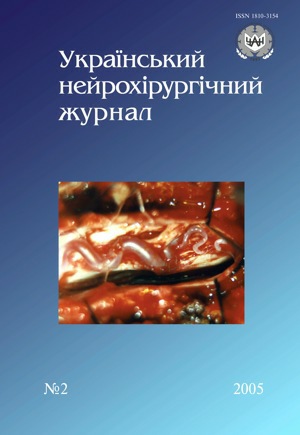The сhanges of free-radical activity in children and teenagers suffering from epilepsy and the rehabilitation normobaric hypoxytherapy influence on pro- and antioxidative status
DOI:
https://doi.org/10.25305/unj.132291Keywords:
епілепсія, перекисне окиснення ліпідів, гіпоксія, загальна антиоксидантна активністьAbstract
The activity markers of free-radical oxidation and antioxidative status in blood of children and teenagers suffering from different forms of epilepsy, which were subjected to generally established conservative or neurotherapy, were studied The considerable changes of pro- and antioxidative status, namely the inhibition of general antioxidant activity and activation of free-radical oxidation in the course of disease development were noticed. In our experimental study we used blood, plasma and homogenized brain tissue of rats. The solution of bemegride was injected to animals to initiate the elevated convulsive readiness, and the study of pro- and antioxidative status markers was carried out in 16 days after injection. As a factor, that promoted correction and increased pro- and antioxidative status, normobaric hypoxic training of animals was used.
In the course of our experiments, we observed the increase of free-radical oxidation and elevation of SOD and catalase activity, which was accompanied by general antioxidant activity decrease. Further, under influence of hypoxic training, the normalization of pro- and antioxidative processes, disturbed because of increased convulsive activity after bemegride injection, was obtained.
We came to conclusion that the general antioxidative activity should be taken into account while carrying out antioxidant correction. It should be also mentioned that neurotherapy accepted course does not promote the sufficient restoration of pro- and antioxidative status, that has to be corrected with antioxidants or other agents application.
References
Барабой В.А., Сутковой Д.А. Окислительно-антиоксидантный гомеостаз в норме и патологии / Под ред. акад. АМН Украины Ю.А. Зозули. — К.: Чернобыльинтеринформ, 1997. — 413 с.
Березовський В.А., Горбань Є.М., Лєвашов М.І., Сутковой А.Д. Гіпоксичне тренування (метод підвищення неспецифічної резистентності організму за допомогою нормобаричної переривчастої гіпоксичної стимуляції) як засіб профілактики та безмедикаментозної терапії. — К., 2001. — 24 с.
Болдырев А.А., Куклей М.Л. Свободные радикалы в нормальном и ишемическом мозге // Нейрохимия. — 1996. — Т.13. — С.25–29.
Закарян А.К., Бабок Ю.В. Сверхслабые свечения в медицине и сельском хозяйстве. — М., 1974. — 88 с.
Зозуля Ю.А., Барабой В.А., Сутковой Д.А. Перекисное окисление липидов и антиоксидантная защита при патологии головного мозга. — М.: Знание-М, 2000. — 344 с.
Клебанов Г.И., Бабенкова И.В., Теселкин Ю.О. и др. Оценка антиокислительной активности плазмы крови с применением желточных липопротеидов // Лаб. дело. — 1998. — №5. — С.59–62.
Королюк М.А., Иванова Л.И., Майорова И.Г., Токарев В. Е. Метод определения активности каталазы // Лаб. дело. — 1988. — №1. — С.16–19.
Крыжановский Г.Н. Сравнительный анализ содержания продуктов перекисного окисления липидов в коре головного мозга, спинномозговой жидкости и периферической крови при эпилептической активности // Бюл. эксперим. биологии. — 1983.— Вып.11. — С.36–38.
Матюшина Б.Н., Логинов А.С., Ткачев В.Д. Определение супероксиддисмутазной активности в материале пункционной биопсии печени при её хроническом поражении // Лаб. дело. — 1991. — №7. — С.16–19.
Никушкин Е.В. Перекисное окисление липидов в ЦНС в норме и при патологии // Нейрохимия. — 1989. — Т.8, №1. — С.124–145.
Окислительный стресс, апоптоз и повреждение мозга. Материалы Междунар. Симпоз. (Питтсбург, США; 21–25 сент.1995 г.) // Нейрохимия. — 1996. — Т.13, вып.1. — С.61–64.
Стальная И.Д., Гаришвили Т.Г. Метод определения малонового диальдегида с помощью тиобарбитуровой кислоты // Современные методы в биохимии. — М.: Медицина, 1977. — С.66–68.
Шакаришвили Р.Р. Свободнорадикальная патология у больных эпилепсией // Клиника и лечение эпилепсии: Сб. науч. тр. — Тбилиси, 1986. — С.131–145.
Satya-Murty S., Howard L., Krohel G., Wolf B. The spectrum of neurologic disorder from vitamin E deficiency // Neurology. — 1986. — V.36, N7. — Р.917–921.
Downloads
How to Cite
Issue
Section
License
Copyright (c) 2005 D. A. Sutkovoy, O. O. Laponogov, G. A. Kevorkov, A. B. Dmytrenko, A. N. Morozov, A. D. Sutkovoy

This work is licensed under a Creative Commons Attribution 4.0 International License.
Ukrainian Neurosurgical Journal abides by the CREATIVE COMMONS copyright rights and permissions for open access journals.
Authors, who are published in this Journal, agree to the following conditions:
1. The authors reserve the right to authorship of the work and pass the first publication right of this work to the Journal under the terms of Creative Commons Attribution License, which allows others to freely distribute the published research with the obligatory reference to the authors of the original work and the first publication of the work in this Journal.
2. The authors have the right to conclude separate supplement agreements that relate to non-exclusive work distribution in the form of which it has been published by the Journal (for example, to upload the work to the online storage of the Journal or publish it as part of a monograph), provided that the reference to the first publication of the work in this Journal is included.









